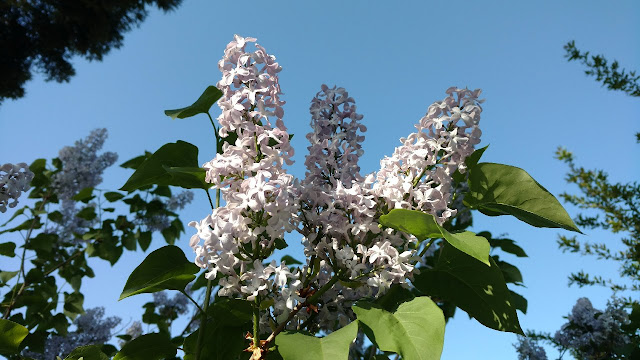Winter chill brings out spring lilacs
 |
| Lilacs are putting on a show right now, thanks to enough winter chill hours. (Photos: Debbie Arrington) |
Even low-chill varieties need some cold time
By Debbie Arrington
More proof we had a chilly (if dry) winter: Lilacs.
Throughout my Sacramento neighborhood, lilacs are putting on a spectacular spring show. That includes my own backyard.
Of course, these are “low-chill” varieties such as Lavender Lady, California Rose and Angel White. They still need a considerable amount of “chill hours” (often 500-plus), but nowhere near that of higher chill varieties. Chill hours measure the time spent below 45 degrees.
 |
| Unfortunately the perfume of these lilacs can't be shared in print. |
But that was enough to prompt those local “low-chill” lilacs to bloom like crazy.
Now is a good time to shop for lilacs in nurseries or admire them in landscapes. This when they look (and smell) their best.
Even with plenty of chill, common lilacs (Syringa vulgaris) and their hybrids can be tricky to get to bloom year after year. Like hydrangeas, their flowers are dependent on well-timed (or no) pruning.
Next spring’s flowers form on the stems right after this year’s blooms are done. But you’ve got to do something; leaving the spent flowers on the bush can inhibit blooming the next year, too.
The trick is to snip off the spent blooms where the leaves join the stem just above where the new buds are forming. Don’t prune heavily and never after Memorial Day; if you do, you won’t have flowers the next spring.
Lilacs don’t need much fertilizer. Give them a little bone meal while they’re dormant in winter. They need at least six hours a day of sun and good air circulation. (When crowded, they can develop powdery mildew.) In Sacramento, they prefer morning sun and some afternoon shade; otherwise, they can get sunburned.
 |
| Bees enjoy lilacs, too. |
Butterflies and beneficial insects love lilacs. Expect to see swallowtails enjoying this spring bloom.
Lilacs also require patience. After transplanting, a new bush may not bloom for three years – or more. But once established and comfortably chilly, it will start flowering relatively reliably for decades to come.


Comments
Post a Comment